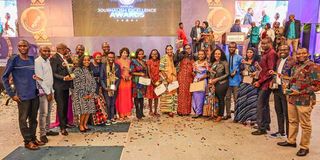
Some of the Nation Media Group journalists who won awards in the 12th Ajea at Edge Convention Centre, Nairobi, on May 3.
To know whether a news story is reliable, you need to be aware of the importance of sources. They are the backbone of quality journalism and it is essential for the reader to know how they are used. It is the only way you can develop a discerning eye for the news you consume.
Sources provide the journalist with the information that he uses to construct his story. If a reporter uses only one source, it is called single-source journalism. This can make it difficult for a reader to assess the credibility and accuracy of the information. So it behooves journalists to use multiple sources.
There are instances, however, when single sources are sufficient. For example, when the story is about the account of an eyewitness who may be the only available source of information. But regardless of if it is a single source or multiple sources, sources should be credible, trustworthy and relevant .
And when presenting sources, the journalist should be honest and as specific as possible in describing them. It is unacceptable, for example, to refer to sources merely as “sources”, or “a source”, “observers”, “reliable” or “authoritative” with no further information as to who they are.
As a reader, what you need to do is to look to see if the story has multiple sources. Multiple sources is one of the most effective ways of ensuring all sides of a story are covered. There are at least two sides to every story. So, most stories should have at least two sources. But the number of sources can vary, depending on the nature of the story.
Ensuring fairness
Multiple sources help to ensure a story is balanced, especially in controversial cases. When a story has a single source, it is difficult for the reader to know whether it is accurate or reliable or not. Multiple sources also help in ensuring fairness.
You should also evaluate the relevancy and credibility of the sources, which can be determined by considering their knowledge and motivation. You should also look to see if they have a relationship with the news that could make them biased. And if they have asked for anonymity, do they have a good reason for it?
The NMG editorial policy is helpful in this regard. It requires journalists not to use unnamed sources unless the pursuit of truth will best be served that way. And journalists should indicate in the stories why the sources do not want to be named.
By being mindful of the type of sources in an article, you are taking a critical step towards becoming an informed consumer of news. You will be better equipped to separate accurate, impartial and high-quality journalism from inaccurate, biased and cheap journalism.
* * *
There were many lessons from the speeches at the Annual Journalism Excellence Awards (Ajea) last Friday. But I am zeroing in on what was voiced by Victor Bwire, the Media Council of Kenya (MCK) Director for Media Training and Development, because of its importance in determining quality journalism.
Mr Bwire said a single-source story cannot be a winner at Ajea. The judges looked at the number of sources used and their relevance.
“If you are doing a story on climate change, a serious climate change story, and you quote the Majority Leader MCA from your village, while the MCA is knowledgeable on matters of climate change, he might not be very relevant,” he said.
For a journalist to win an Ajea award, he must use relevant, knowledgeable, credible and reliable sources. Bwire cited the example of a story on Lake Victoria which has been telling readers that the lake is going to be extinct.
“The story has been told for the past 30 years.... There is a newspaper that carries that story every year,” he said. Yet, in the same lake, fish has been thriving, but the story has not told readers “which is this fish that is getting extinct”.
It is true that winning a prize with a single-sourced story is uncommon anywhere in the world. Judges of journalism awards value thoroughness, accuracy and depth in journalism.
A single-sourced story raises concerns about the credibility and fairness of a story, which could negatively impact the chances of winning an award like the Ajea.
The Public Editor is an independent news ombudsman who handles readers’ complaints on editorial matters including accuracy and journalistic standards. Email: [email protected]. Call or text 0721989264.










